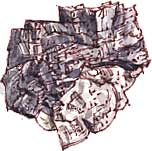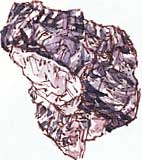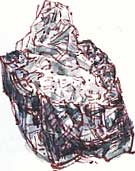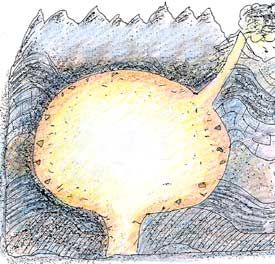


Wild West Yorkshire, Thursday 11 November 2010
previous | this month | next



MINERALS aren't my strong point. Rocks, yes, I like them because they've got such a story to tell; they're in layers like the pages of a book, and, like a book, they're often illustrated with traces of fossil life they've encountered and with features that record their journey through the planet's climate belts and their involvement in continental collisions. Rocks are the bones of the living landscape and of the man-made landscape. Minerals are such basic units in the story of the Earth that they can seem like a glittering abstraction rather than a true part of the story, but that isn't true, they're the building blocks of the rocks so I should take more interest in them.
Even I can identify this heavy, lustrous mineral as the lead ore galena. It's got a specific gravity of 7.58 which means that it's seven and a half times as heavy as an equal volume of water. One of the sulphides, its chemical composition is expressed simply as PbS.
 Romans in the Pennines
Romans in the PenninesPb is from plumbum, the Latin for lead. It's a word you might have heard used in the Peak District or the North Pennines almost two thousand years ago as the Roman mined and smelted lead in northern England. Ingots or 'pigs' of lead have been found at various sites. I think the specimen of galena I've drawn is from the North Pennines.
On the left-hand drawing above you can see that the habit - the shape of the crystal - of galena is often cubic. You can also just make out that it has a 'stepped' pattern of cleavage, as if it has been laminated out of sheets of material.
 Origins
OriginsSo much for the mineral as seen in isolation as a hand specimen but to see it as part of the story of the formation of the Pennines, you need to know that galena forms in hydrothermal veins. The Pennines aren't noted for the remains of extinct volcanoes, although 320 million years ago in the Carboniferous period there were undersea vents producing a bubble-filled lava that would become the spotted 'toadstone' at Tideswell in the Peak District. Hydrothermal activity is caused by fluids rich in minerals moving through rocks surrounding molten masses of granite (left). There's a granite bbeneath the Pennines at Weardale, county Durham.
Galena can form alongside a variety of minerals so what are the white rock crystals in this specimen? They're not glassy like quartz. I'd guess at calcite but fluorite can also be white. One test for fluorite is that it is strongly fluorescent under ultra-violet light. Perhaps I should head down to the nearest tanning parlour to check it out.
Richard Bell, illustrator
previous | this month | Wild West Yorkshire home page | next